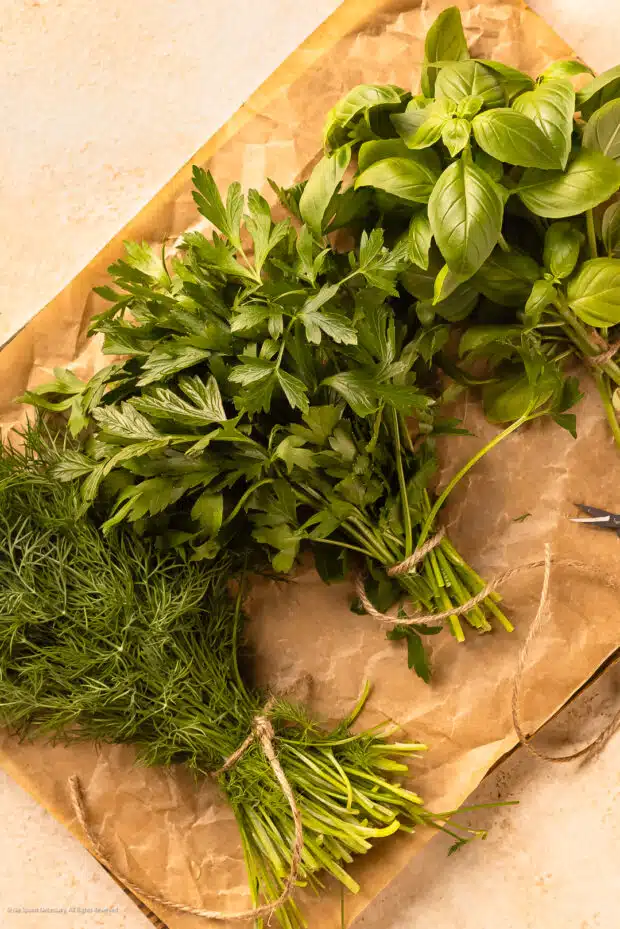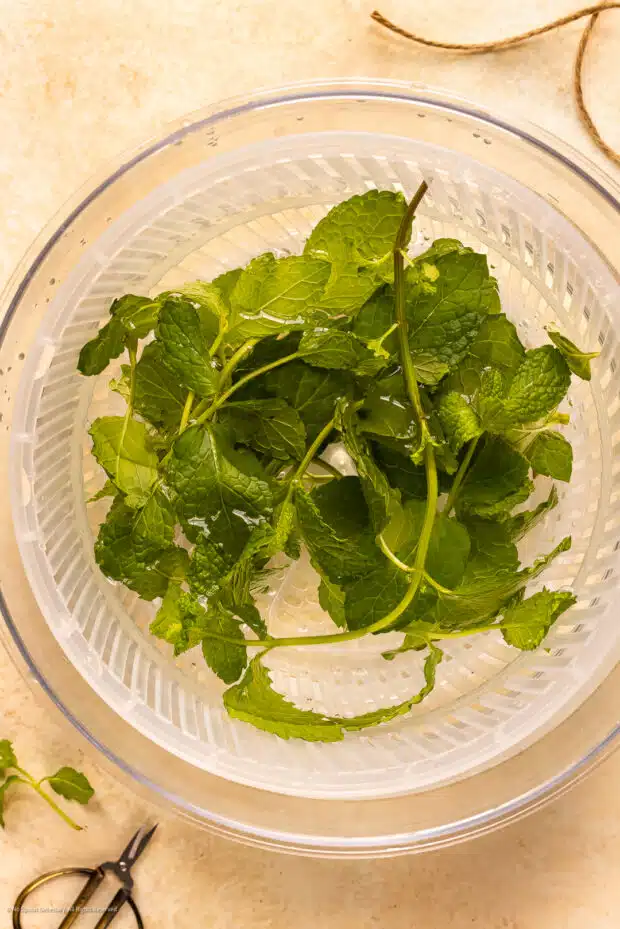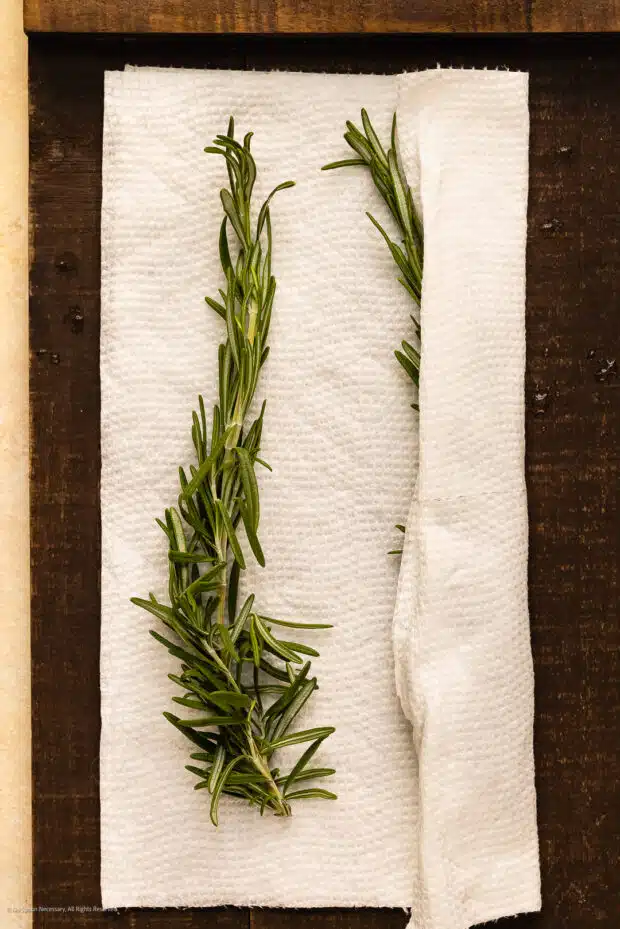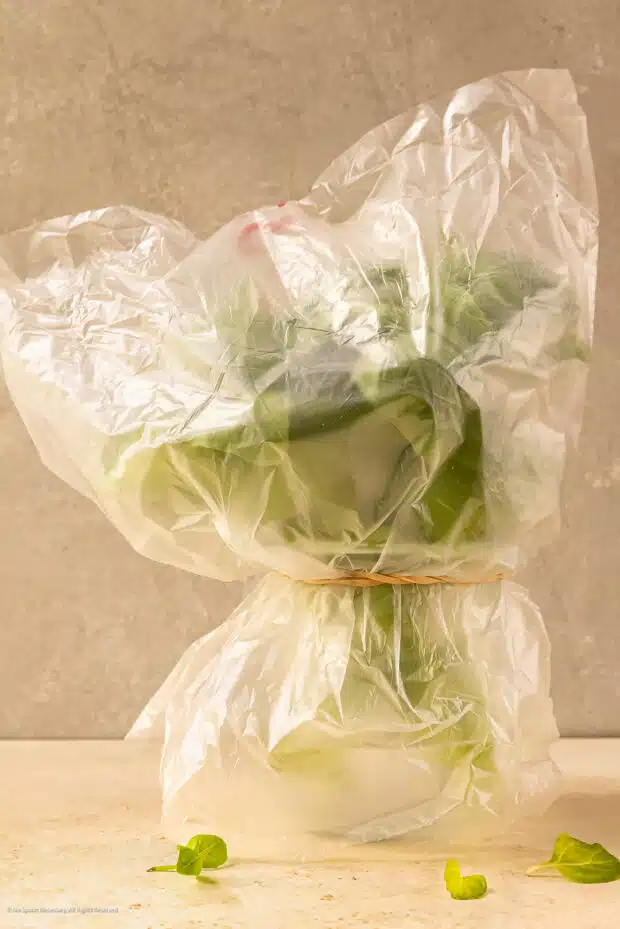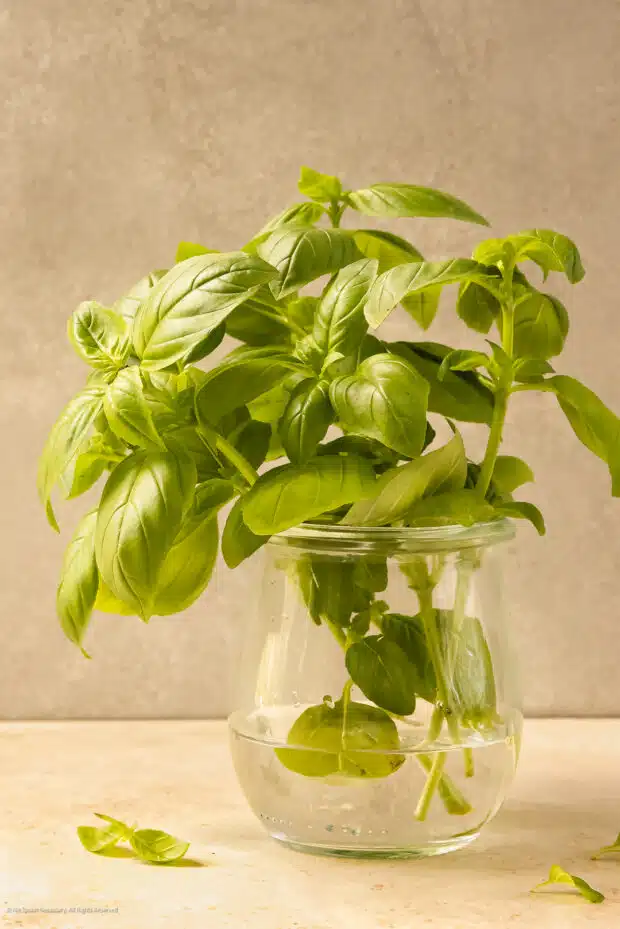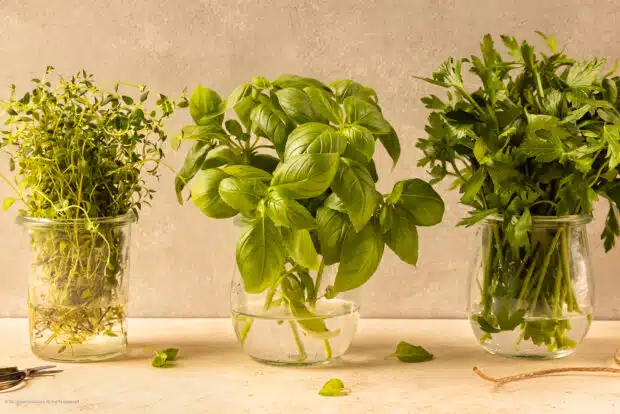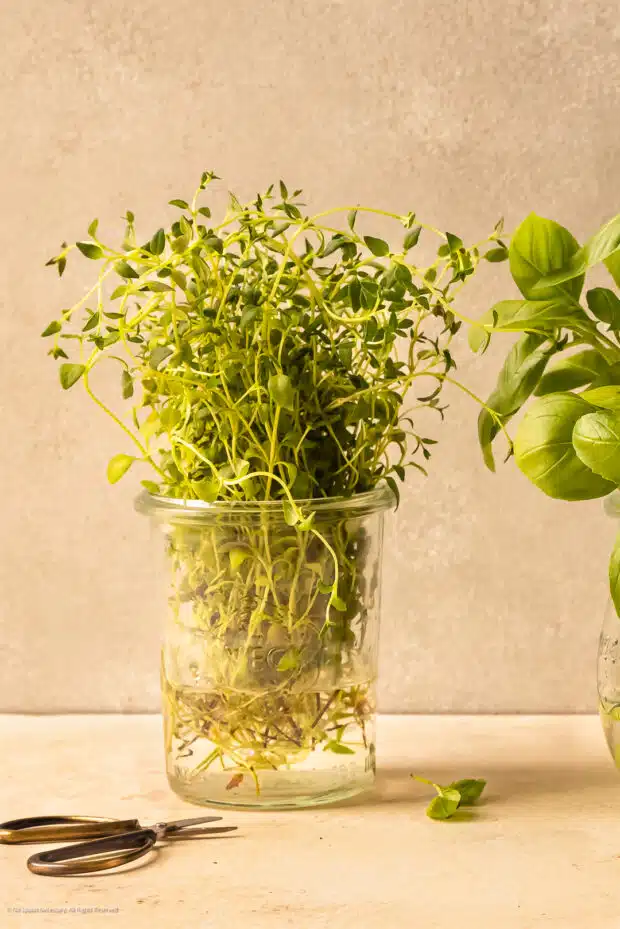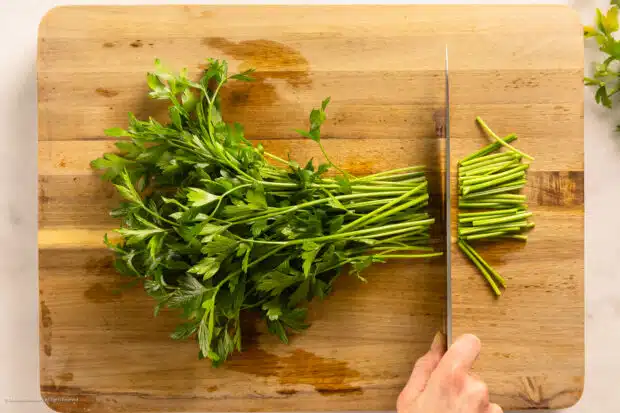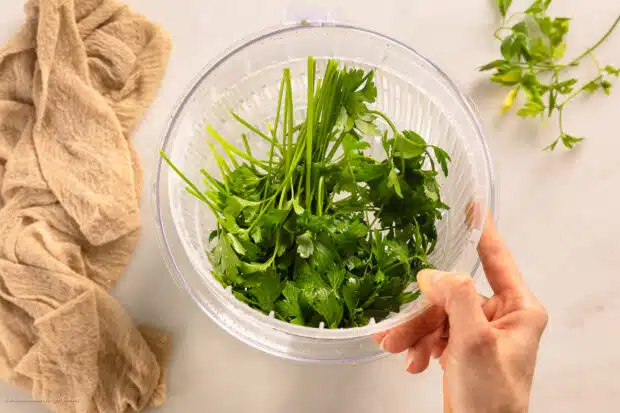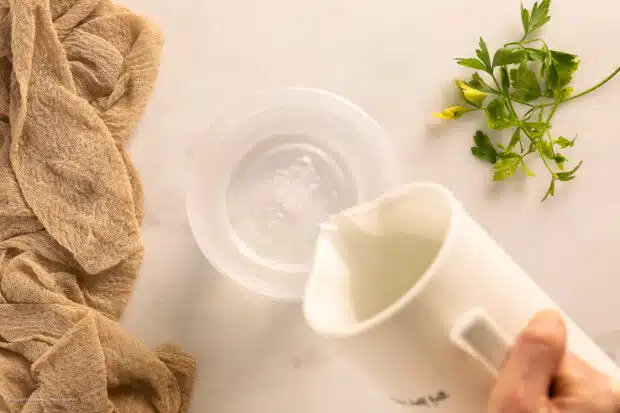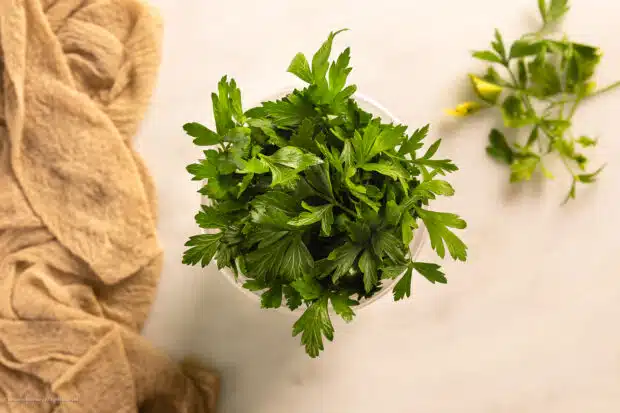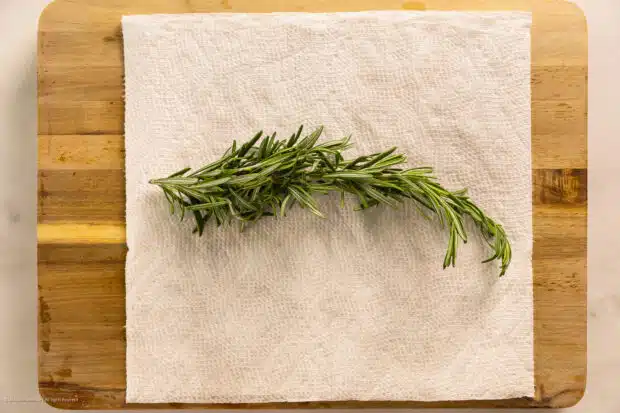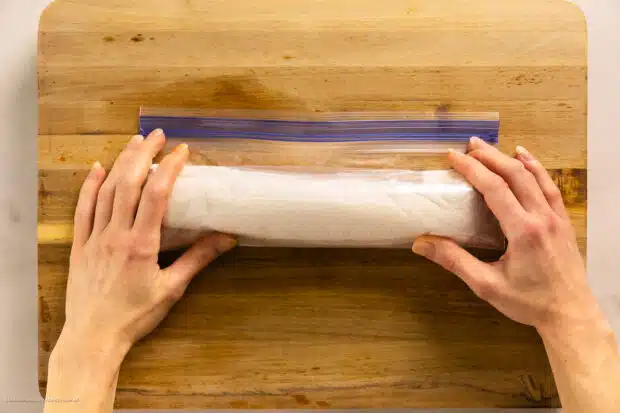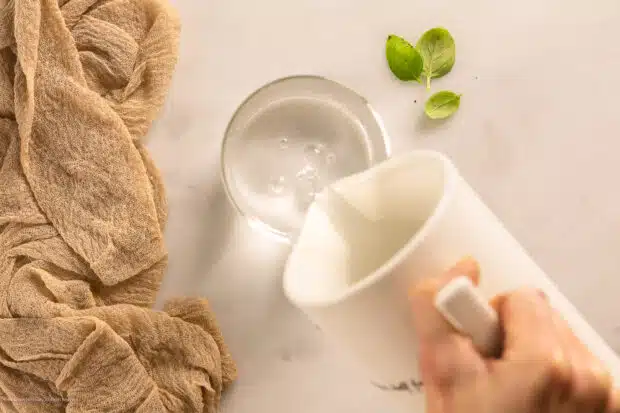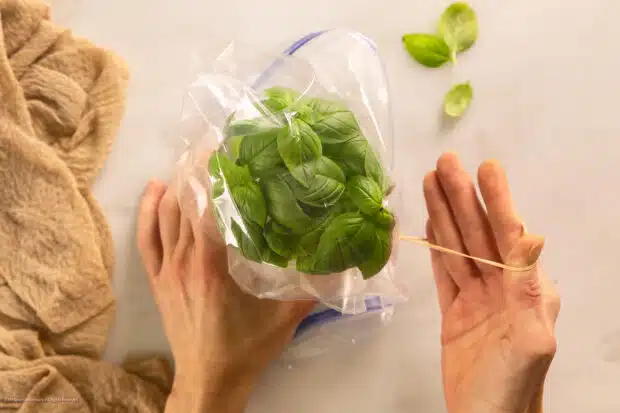This post may include affiliate links. Thank you for your support.
Stop wasting your hard-earned money and learn some simple tricks for How to Store Fresh Herbs to so they stay fresh and flavorful for days! If you’ve ever wondered about herb storage and how to extend their shelf life to keep different fresh herbs, well… FRESH, this in-depth tutorial on storing herbs is for you!
Table of Contents
- Why you should learn how to store fresh herbs
- How to prepare any fresh herbs for storage
- How to store hard, woody herbs
- How to store tender herbs
- How to store basil
- Best way to store fresh herbs long term
- Expert tips for fresh herb storage
- FAQs: storing fresh herbs
- More free resourceful kitchen tutorials!
- Best Way to Store Fresh Herbs
Why you should learn how to store fresh herbs
I think I can safely say we’ve all felt the pinch of rising food costs lately, right? Like, when did a 14-ounce shrink-flated “pint” of ice cream surpass $8?!?! 😱
Well, if you’re anything like me, you’ve been scheming different ways to make your food budget stretch further. I’m here to tell you: proper food storage is a surefire way to make sure you’re not throwing your $$$ away!
I’ve always touted the power of fresh herbs to take a dish from “ho-hum” to “party in your mouth.” Seriously, just add a sprinkle of cilantro to your next plate of tacos, or some fresh dill to your smoked salmon dip and see how much it changes things!
BUT, even herbs have become wildly expensive, it seems. Heck, I just shelled out $3 for a teensy-weensy clamshell of rosemary that only had 2 real sprigs in it! If you’re someone who shops just once a week, chances are good that your herbs will get moldy in their plastic packaging before you can even get to them.
So, rather than let those surprisingly spendy flavor-boosters go to waste, I’m here to teach you the (extraordinarily simple) ways how to make fresh herbs last longer. Seriously, all you need is about 5 minutes and a few basic pieces of equipment!
Equipment you’ll need for storing herbs
As promised, you only need a handful of tools to keep herbs fresh in the fridge (or on the counter!). Here’s what to grab for fresh herb storage:
- Colander
- Salad Spinner
- Clean Kitchen Towels or Paper Towels
- Quart-Sized Mason Jars (for tender herbs)
- Plastic Bag (for woody herbs)
How to prepare any fresh herbs for storage
While there are different methods of storing fresh herbs (depending on which herbs you’re working with), the process to prepare them is the same.
- Step 1: Snip and Pick Over Herbs. Pick over the fresh herbs, removing and discarding and discolored, wilted, or bad looking herbs. Next, place the herbs on a clean work surface. Then snip off about ½ inch of the base ends and discard them.
- Step 2: Wash Herbs. Place the colander of a salad spinner or a fine mesh colander into a large bowl. Fill the bowl with COLD water and then add the fresh herbs. Use your hands gently to agitate the water and clean the herbs. Lift the salad spinner or colander out of the bowl of water. Place the salad spinner colander into the salad spinner and spin until dry. Next, line a clean work surface with paper towels. Gently dump the dried herbs onto the towels and gently pat thoroughly dry. (See below for fresh herb storage according to the type of herbs.)
How to store hard, woody herbs
“Hard, woody herbs” include chives, oregano, rosemary, sage, savory, scallions, and thyme.
- Step 1 and 2: Snip, pick over, and wash herbs according to the directions above.
- Step 3: Hard Herb Storage Method. Dampen a double layer of paper towels and place on a clean work surface. Place the fresh herbs in the middle of the damp paper towels and gently wrap the paper towels around the herbs, woody stems and all. Transfer the package of herbs to a resealable storage bag, press out the air, and seal the bag.
- Step 4: Store hard herbs in the fridge for 1 week or longer.
How long will hard herbs last?
- Chives: up to 1 week
- Rosemary: up to 3 weeks
- Thyme: up to 2 weeks
- Sage: up to 2 weeks
- Savory: up to 2 weeks
- Scallions: up to 1 week
How to store tender herbs
“Tender herbs” include cilantro, chervil, dill, mint, curly OR flat leaf parsley, and tarragon.
- Step 1 and 2: Snip, pick over, and wash herbs according to the preparing herbs section above.
- Step 3: Tender Herb Storage Method. Fill the bottom of a 1-quart mason jar, plastic deli container, canning jar, or other large jar with about an inch to an inch-and-a-half of water. Next, place the fresh herbs inside the jar with the stem-side down in the water, like a bouquet of flowers. Finally, cover the top of the storage container tightly with a tight-fitting lid or an overturned resealable storage bag, or the plastic vegetable bag provided by the grocery store. Just make sure you seal the bag against the base of the jar to keep air out. (Tip: I typically just use the tie from the fresh herb bundle to tie the storage bag to the container.)
- Step 4: Store fresh tender herbs in the fridge for 1 week or longer.
How long will tender herbs last?
- Cilantro: up to 3 weeks
- Chervil: up to 10 days
- Dill: up to 2 weeks
- Mint: up to 2 weeks
- Parsley: up to 3 weeks
How to store basil
Basil is in her own special category. While she’s technically a tender herb, she’s also a real summer girl through and through — she hates the cold of the refrigerator! Properly stored basil will last for up to 2 weeks.
- Step 1 and 2: Snip, pick over, and wash herbs to remove dirt according to the preparing herbs section above.
- Step 3: Basil Storage Method. Fill the bottom of a 1-quart mason jar, plastic deli container, canning jar, or other large jar with two inches of water. Next, place the fresh herbs inside the jar with the stem-side down in the water. Finally, cover the top of the storage container tightly with a tight-fitting lid.
- Step 4: Store fresh basil on the kitchen counter for up to 2 weeks.
Put your fresh basil to good use in these recipes: Basil Hummus Recipe, Homemade Tomato Basil Soup, and the most amazing Strawberry Basil Cocktail.
Best way to store fresh herbs long term
Can’t get to all your fresh herb deliciousness in the time allotted? Not to worry! There’s another method we haven’t discussed: DRYING.
You know those bottles of herbs in your spice cabinet? Well, they all started out as fresh and vibrant as the ones you’ve been storing in water. While I prefer using fresh herbs for many applications (see pesto and pesto salads, chimichurri, and chermoula sauce), dry herbs still have their uses. And, let’s face it, dry herbs are better than moldy herbs!!
SO, if you can’t get to your fresh buddies in time:
- Step 1: Remove them from the water, then pat them totally dry.
- Step 2: Secure the root ends with some kitchen twine, dental floss, or embroidery thread.
- Step 3: Use a magnetic chip clip to grab hold of the root ends, then hang them upside down (with the root side facing the ceiling).
- Step 4: Wait until the herbs dry completely, then gently remove all the leaves and discard the stems.
- Step 5: Decant the dried herbs into airtight storage bottles, label and date them, and then use within 6 months to a year for the best results.
Expert tips for fresh herb storage
- One bad apple can ruin the barrel. When you get home from the supermarket, pick over and discard any of the bad looking herbs. These bad herbs can cause the rest of your fresh herbs to decay faster.
- Cleanliness is next to godliness. Unwashed fresh herbs will start to show signs of decay DAYS faster than washed fresh herbs. However, too much moisture is a common enemy to all fresh herbs, therefore it’s important to thoroughly dry the herbs before storing. I recommend a salad spinner for the best results.
- No Salad Spinner? No problem! Alternatively, you can drain the herbs in the colander, and then gently dump the washed herbs out onto a paper towel-lined work surface. Use the paper towels to pat the herbs thoroughly dry, removing all excess moisture.
- Keep your eye out for roots. There are a few herbs that are actually pretty likely to actually GROW if you store them properly. (Neat, right?!?) Basil and scallions are known for this! If you start seeing roots growing, you can totally plant them in soil if you want to keep the party going.
- Change the water. Every few days, give your herbs a fresh load of water to sip up. This will help prevent bacteria and molding, and will also give you a chance to inspect the herbs and remove any decaying leaves.
- Keep the leaves out of the water. While you definitely want the stems in water so they can drink, do you best to keep the leaves dry. As noted above, moisture is the enemy of keeping leaves nice and fresh.
FAQs: storing fresh herbs
How long do fresh herbs last?
It all depends on the type of herb and whether or not you’ve stored it properly. As noted above, the best way to store fresh herbs will vary whether it’s a tender herb or a woody herb. And remember, basil gets her own special, toasty storage!
Most cut herbs will last for about 1-2 weeks if they are given the proper conditions.
What are fresh herbs?
Fresh herbs are edible, flavor-boosting plants that are still fresh, like a bouquet of fresh flowers. In this informative blog post about fresh herb storage, we discuss the best ways to store cut herbs so they last as long as possible!
What is the best way to store herbs from the garden?
It probably goes without saying, but if you are growing fresh herbs and the weather is nice, the BEST way to keep them fresh is to snip only what you need and let the plant take care of itself. However, if you’re wondering what to do with herbs once cut, follow the instructions listed above to get as much time out of them as possible!
How to keep fresh herbs longer than a week or two?
If you can’t get to your fresh herbs before they start going downhill, I suggest drying them. Read above for easy instructions!
Which herbs should I use?
Lucky you, I wrote a whole post about it! Check out this Fresh Herb Guide to help you decide.
Craving MORE? Follow all the deliciousness on Facebook, Pinterest and Instagram!
More free resourceful kitchen tutorials!
- Stocking the Pantry for Better Home Cooking
- Food to Feed a Crowd
- How to Thaw Frozen Shrimp Properly
- Cleaning Shrimp Tutorial: How to Peel and Devein Shrimp
- Macerating Fruit – what it means and why you’d want to
- Bakery Conversion Chart
- Conversion Chart for Cooking
- How to Half a Recipe
- Food Substitute List
Recipe tutorial for storing herbs👇
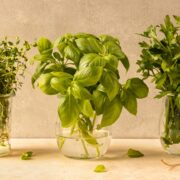
Best Way to Store Fresh Herbs
Equipment
- 1 Colander
- 1 Salad Spinner - OPTIONAL
- 1 1 Quart Storage Jars (for storing tender herbs + basil)
- 1 Paper Towels + Gallon Storage Bags (for storing woody herbs)
Ingredients
- 1 Bunch Fresh Herbs (SEE NOTES)
Instructions
- Snip and Pick Over Herbs: Pick over the fresh herbs, removing and discarding and discolored, wilted, or bad looking herbs. Next, place the herbs on a clean work surface. Then snip off and discard the base ends.
- Wash Herbs: Place the colander of a salad spinner or a fine mesh colander into a large bowl. Fill the bowl with COLD water and then add the fresh herbs. Use your hands gently to agitate the water and clean the herbs. Lift the salad spinner or colander out of the bowl of water. Place the salad spinner colander into the salad spinner and spin until dry. Next, line a clean work surface with paper towels. Gently dump the dried herbs onto the towels and gently pat thoroughly dry. (No Salad Spinner? Alternatively, you can drain the herbs in the colander, and then gently dump the washed herbs out onto a paper towel-lined work surface. Use the paper towels to pat the herbs thoroughly dry, removing all excess moisture.)
Storing Tender Herbs (cilantro, chervil, dill, mint, parsley – curly, parsley – flat leaf, and tarragon)
- Storage Method: Fill the bottom of a 1-quart mason jar, plastic deli container, canning jar, or other large jar with about an inch to an inch-and-a-half of water. Next, place the fresh herbs inside the jar with the stem-side down in the water. Finally, cover the top of the storage container tightly with a tight-fitting lid. Alternatively, you can use an overturned resealable storage bag, or the plastic vegetable bag provided by the grocery store. Just make sure you seal the bag against the base of the jar to keep air out. (Tip: I typically just use the tie from the fresh herb bundle to tie the storage bag to the container.)
- Store soft herbs in the fridge for 1 week or longer (see chart for herb storage estimations).
Storing Woody Herbs (chives, oregano, rosemary, sage, savoy, scallions, and thyme)
- Storage Method: Damped a double layer of paper towels and place on a clean work surface. Place the fresh herbs in the middle of the damp paper towels and gently wrap the paper towels around the herbs. Transfer the package of herbs to a resealable storage bag, press out the air, and seal the bag.
- Store hard herbs in the fridge for 1 week or longer (see chart for herb storage estimations).
Storing Basil
- Storage Method: Fill the bottom of a 1-quart mason jar, plastic deli container, canning jar, or other large jar with about an inch to an inch-and-a-half of water. Next, place the fresh herbs inside the jar with the stem-side down in the water. Finally, cover the top of the storage container tightly with a tight-fitting lid. Alternatively, you can use an overturned resealable storage bag, or the plastic vegetable bag provided by the grocery store. Just make sure you seal the bag against the base of the jar to keep air out. (Tip: I typically just use the tie from the fresh herb bundle to tie the storage bag to the container.)
- Store fresh basil at room temperature for up to 2 weeks.
Notes
- Discard: When you get home from the supermarket, pick over and discard any of the bad looking herbs. These bad herbs can cause the rest of your fresh herbs to decay faster.
- Washing: Unwashed fresh herbs will start to show signs of decay DAYS faster than washed fresh herbs. However, too much moisture is a common enemy to all fresh herbs, therefore it’s important to thoroughly dry the herbs before storing. I recommend a salad spinner for the best results.
- See the list below for approximate length of time fresh herbs will keep.
- Tender Herbs:
- Cilantro: up to 3 weeks
- Chervil: up to 10 days
- Dill: up to 2 weeks
- Mint: up to 2 weeks
- Parsley: up to 3 weeks
- Basil: up to 2 weeks
- Woody Herbs:
- Chives: up to 1 week
- Rosemary: up to 3 weeks
- Thyme: up to 2 weeks
- Sage: up to 2 weeks
- Savoy: up to 2 weeks
- Scallions: up to 1 week
Did you make this recipe?
Mention @nospoonnecessary on Instagram and tag it #nospoonnecessary!
©No Spoon Necessary. All images and content are under copyright protection. Please do not use any images without prior permission. Kindly do not publish this recipe without prior consent. To reference this recipe, please link directly to this post.

